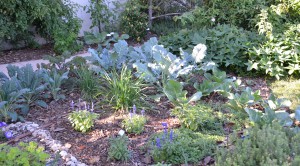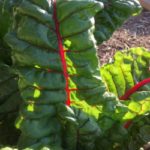Here are our 10 tips for a successful vegetable garden (en español). Growing your own food can be immensely satisfying. It’s also labor intensive and maddening if you don’t get it right.

The vegetable garden at the Travis County AgriLife office
- Seek Local Advice
- independently owned nurseries usually source locally too and are more in tune with what will grow well
- AgriLife Extension is staffed with local experts and has access to research-based advice
- Find a Good Location
- most vegetables require 6-8 hours of sunlight
- select a location that is close and convenient to the kitchen
- Ensure Adequate Moisture and Drainage
- locate garden near a source of water
- build raised beds if soil quality is poor
- use drip or soaker hoses, 1-1 ½ inches per week to deliver water where it’s needed
- Build Healthy Soil
- ideal pH is 6.5 – 7.0
- strive for 8-12” of loose, friable soil
- perform a soil test, use fertilizer as indicated
- incorporate compost or other organic matter
- Use Mulch
- retains water, controls weeds, regulates soil temperature
- use leaves, compost, dried grass clippings, alfalfa hay, finely shredded bark
- Plant the Right Plant at the Right Time
- cool season/warm season (first frost=mid-November, last freeze=mid-March)
-

Swiss Chard at the Travis County AgriLife office demonstration garden
use recommended varieties
- Monitor for Problems
- inspect your plants regularly
- Control Pests and Disease
- use resistant varieties – for tomatoes, look for the VPN designation (Verticillium wilt, Fusarium, and Nematode disease resistance)
- practice proper sanitation and crop rotation
- protect plants with floating row cover
- get to know the beneficial insects
- Harvest at the Right Time
- pick at proper maturity for peak flavor and quality
- harvest frequently to encourage blooms
- Eat What You Grow!
- fresh produce is packed with vitamins and antioxidants
- learn how to preserve your harvest and enjoy home-grown food all year long

Photo courtesy of Kerry Drake, Sunshine Community Gardens
